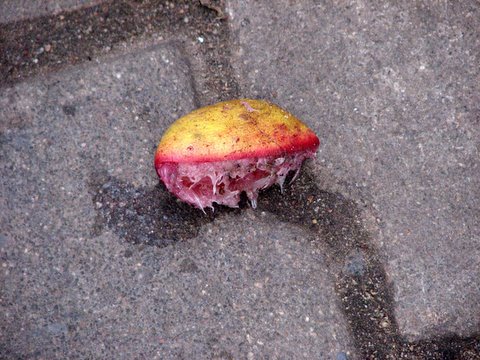Averting the evil eye
Here’s a picture that is quite familiar to Indians, but would be something rather intriguing to non-Indians:
That’s half-a-lemon, which has been dipped in “sindoor” (vermilion powder), and then crushed in front of a newly-opened shop (this particular one was in Basavanagudi.)And the reason for it is really fascinating.
In India (and probably, in many other cultures) we have this concept of the “evil eye”. When one is starting a new initiative, or business, or flourishing in some endeavour, we are worried that the envy and jealousy of others will, in the form of negative vibrations, affect our success or blight our efforts.
And we try to avert the “evil eye” of jealousy by several means; we hang up stuff that would actually mar the appearance of the new home, vehicle, or the new shop. We put up really ugly scarecrows on the top of a new home being constructed; we paint scary faces on the axles or backs of vehicles, like this one:
and we string up things that would not be palatable, like chillies,lemons and even bits of coal.
All these, by marring the appearance of the new endeavour, are supposed to make the potential jealous glance get diluted with the thought, “But that thing in front of it so ugly!” and thus avert the negative energy of the Evil Eye.
But we also like to propitiate potentially malign forces in age-old ways…one of them being sacrifice. As far as I can remember, from the dawn of civilization, man has sought to avert the wrath of the gods by offering them something…and that gave rise to ritual sacrifice.Whether it was an animal or a human being, shedding the blood of the sacrificial offering is supposed to appease the gods and prevent them from showing their anger. Slowly, the blood of the sacrifice came to be an important part of the ritual.
The deity of Kali at Kalighat in Kolkata has been a place where I have watched ritual sacrifice of goats. The blood would then be applied on the idol of the goddess. In fact, it is my opinion that this is how the “bindi” that Hindus traditionally wear on their forehead has actually come about, and that, in my opinion, explains the red colour….it is the drop of sacrificial blood that is applied to one’s forehead as a charm or amulet,against ill fortune.
Over a period of time, though, sacrifice became more symbolic. Instead of the animal itself, other things were substituted. In many worship rituals, the “arathi” consists of a plate in which water made red with lime and sindoor is swirled around and spilt at the front door. Or, windows are cut into ashy pumpkins, which are then filled with “sindoor” and the large vegetable is smashed on the road in a remarkable simulation of the “bali” or sacrifice. And in this age of miniaturization, the gourd has now been downsized to the lemon, which is cut into half, and smeared with lime or sindoor, and then squashed, so that the red fluid runs out and offers a protection against the wrath of the gods.
It always fascinates me that my very vegetarian, orthodox Tamizh Brahmin relatives don’t seem to know the …er…bloody significance of the “arathi” that they swirl around in front of their deities during the puja!


